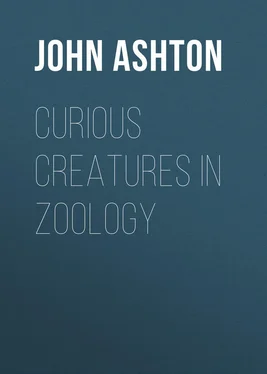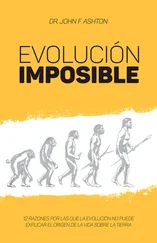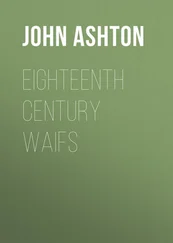John Ashton - Curious Creatures in Zoology
Здесь есть возможность читать онлайн «John Ashton - Curious Creatures in Zoology» — ознакомительный отрывок электронной книги совершенно бесплатно, а после прочтения отрывка купить полную версию. В некоторых случаях можно слушать аудио, скачать через торрент в формате fb2 и присутствует краткое содержание. Жанр: Природа и животные, foreign_antique, foreign_prose, на английском языке. Описание произведения, (предисловие) а так же отзывы посетителей доступны на портале библиотеки ЛибКат.
- Название:Curious Creatures in Zoology
- Автор:
- Жанр:
- Год:неизвестен
- ISBN:нет данных
- Рейтинг книги:4 / 5. Голосов: 1
-
Избранное:Добавить в избранное
- Отзывы:
-
Ваша оценка:
- 80
- 1
- 2
- 3
- 4
- 5
Curious Creatures in Zoology: краткое содержание, описание и аннотация
Предлагаем к чтению аннотацию, описание, краткое содержание или предисловие (зависит от того, что написал сам автор книги «Curious Creatures in Zoology»). Если вы не нашли необходимую информацию о книге — напишите в комментариях, мы постараемся отыскать её.
Curious Creatures in Zoology — читать онлайн ознакомительный отрывок
Ниже представлен текст книги, разбитый по страницам. Система сохранения места последней прочитанной страницы, позволяет с удобством читать онлайн бесплатно книгу «Curious Creatures in Zoology», без необходимости каждый раз заново искать на чём Вы остановились. Поставьте закладку, и сможете в любой момент перейти на страницу, на которой закончили чтение.
Интервал:
Закладка:
A still more remarkable circumstance is, the fact that these persons have two pupils in each eye. Apollonides says, that there are certain females of this description in Scythia, who are known as Bythiæ, and Phylarcus states that a tribe of the Thibii in Pontus, and many other persons as well, have a double pupil in one eye, and in the other the figure of a horse. He also remarks, that the bodies of these persons will not sink in water, even though weighed down by their garments. Damon gives an account of a race of people, not very much unlike them, the Pharnaces of Æthiopia, whose perspiration is productive of consumption to the body of every person that it touches. Cicero also, one of our own writers, makes the remark, that the glance of all women who have a double pupil is noxious.
To this extent, then, has nature, when she produced in man, in common with the wild beasts, a taste for human flesh, thought fit to produce poisons as well in every part of his body, and in the eyes of some persons, taking care that there shall be no evil influence in existence, which was not to be found in the human body. Not far from Rome, in the territory of the Falisci, a few families are found, who are known by the name of Hirpi. These people perform a yearly sacrifice to Apollo, on Mount Soracte, on which occasion they walk over a burning pile of wood, without being scorched even. On this account, by virtue of a decree of the Senate, they are always exempted from military service, and from all other public duties.
Some individuals, again, are born with certain parts of the body endowed with properties of a marvellous nature. Such was the case with King Pyrrhus, the great toe of whose right foot cured diseases of the spleen, merely by touching the patient. We are informed that this toe could not be reduced to ashes together with the other portions of his body; upon which it was placed in a temple.
India and the region of Æthiopia, more especially, abounds in wonders. In India the largest of animals are produced; their dogs, for instance, are much bigger than those of any other country. The trees, too, are said to be of such vast height that it is impossible to send an arrow over them. This is the result of the singular fertility of the soil, the equable temperature of the atmosphere, and the abundance of water; which, if we are to believe what is said, are such, that a single fig tree ( the banyan tree ) is capable of affording shelter to a whole troop of horse. The reeds here ( bamboos ) are of such enormous length, that each portion of them, between the joints, forms a tube, of which a boat is made that is capable of holding three men. It is a well-known fact, that many of the people here are more than five cubits in height. 4 4 The Roman cubit was eighteen inches, so that these men were nearly eight feet high.
These people never expectorate, are subject to no pains, either in the head, the teeth, and the eyes, and, rarely, in any other parts of the body; so well is the heat of the sun calculated to strengthen the constitution… According to the account of Megasthenes, dwelling upon a mountain called Nulo, there is a race of men who have their feet turned backwards, with eight toes on each foot.
On many of the mountains again, there is a tribe of men who have the heads of dogs, and clothe themselves with the skins of wild beasts. Instead of speaking, they bark; and, furnished with claws, they live by hunting, and catching birds. According to the story, as given by Ctesias, the number of these people is more than a hundred and twenty thousand; and the same author tells us that there is a certain race in India, of which the females are pregnant once only in the course of their lives, and that the hair of the children becomes white the instant they are born. He speaks also of another race of men who are known as Monocoli, 5 5 From ἀπὸ τοῦ μονοῦ κώλου, “from having but one leg.”
who have only one leg, but are able to leap with surprising agility. The same people are also called Sciapodæ, 6 6 From Σκιαποῦς, “making a shadow with his foot.”
because they are in the habit of lying on their backs, during the time of extreme heat, and protect themselves from the sun by the shade of their feet. These people, he says, dwell not very far from the Troglodytæ ( dwellers in caves ); to the west of whom again there is a tribe who are without necks, and have eyes in their shoulders.
Among the mountainous districts of the eastern parts of India, in what is called the country of the Catharcludi, we find the Satyr, an animal of extraordinary swiftness. These go sometimes on four feet, and sometimes walk erect; they have also the features of a human being. On account of their swiftness, these creatures are never to be caught, except that they are aged, or sickly. Tauron gives the name of Choromandæ to a nation which dwells in the woods, and have no proper voice. These people screech in a frightful manner; their bodies are covered with hair, their eyes are of a sea-green colour, and their teeth like those of a dog. Eudoxus tells us, that in the southern parts of India, the men have feet a cubit in length, while the women are so remarkably small that they are called Struthpodes. 7 7 Sparrow footed, from στροῦθος, a sparrow.
Megasthenes places among the Nomades of India, a people who are called Scyritæ. These have merely holes in their faces instead of nostrils, and flexible feet, like the body of the serpent. At the very extremity of India, on the eastern side, near the source of the river Ganges, there is the nation of the Astomi, a people who have no mouths; their bodies are rough and hairy, and they cover themselves with a down 8 8 Probably cotton.
plucked from the leaves of trees. These people subsist only by breathing, and by the odours which they inhale through the nostrils. They support themselves neither upon meat nor drink; when they go upon a long journey they only carry with them various odoriferous roots and flowers, and wild apples, that they may not be without something to smell at. But an odour, which is a little more powerful than usual, easily destroys them…
Isogonus informs us that the Cyrni, a people of India, live to their four-hundredth year; and he is of opinion that the same is the case also with the Æthiopian Macrobii, 9 9 Or long livers, from μακρὸς, “long,” and βίος, “life.”
the Seræ, and the inhabitants of Mount Athos. In the case of these last, it is supposed to be owing to the flesh of vipers, which they use as food; in consequence of which they are free also from all noxious animals, both in their hair and their garments.
According to Onesicritus, in those parts of India where there is no shadow, the men attain the height of five cubits and two palms, 10 10 A palm was three inches, so that these men would be eight feet high.
and their life is prolonged to one hundred and thirty years; they die without any symptoms of old age, and just as if they were in the middle period of life. Pergannes calls the Indians, whose age exceeds one hundred years, by the name of Gymnetæ; 11 11 From Γυμνητὴς, one who takes much bodily exercise.
but not a few authors style them Macrobii. Ctesias mentions a tribe of them, known by the name of Pandore, whose locality is in the valleys, and who live to their two-hundredth year; their hair is white in youth, and becomes black in old age. On the other hand, there are some people joining up to the country of the Macrobii, who never live beyond their fortieth year, and their females have children once only during their lives. This circumstance is also mentioned by Agatharchides, who states, in addition, that they live on locusts, and are very swift of foot. Clitarchus and Megasthenes give these people the name of Mandi, and enumerate as many as three hundred villages which belong to them. Their women are capable of bearing children in the seventh year of their age, and become old at forty.
Интервал:
Закладка:
Похожие книги на «Curious Creatures in Zoology»
Представляем Вашему вниманию похожие книги на «Curious Creatures in Zoology» списком для выбора. Мы отобрали схожую по названию и смыслу литературу в надежде предоставить читателям больше вариантов отыскать новые, интересные, ещё непрочитанные произведения.
Обсуждение, отзывы о книге «Curious Creatures in Zoology» и просто собственные мнения читателей. Оставьте ваши комментарии, напишите, что Вы думаете о произведении, его смысле или главных героях. Укажите что конкретно понравилось, а что нет, и почему Вы так считаете.












